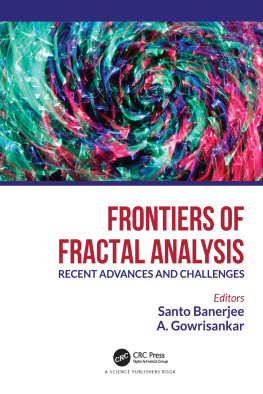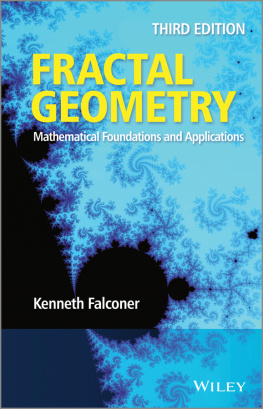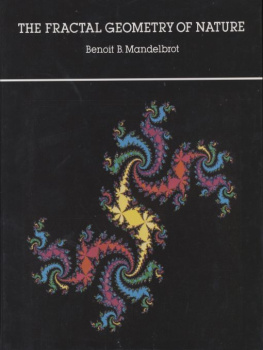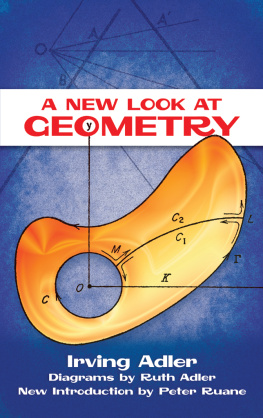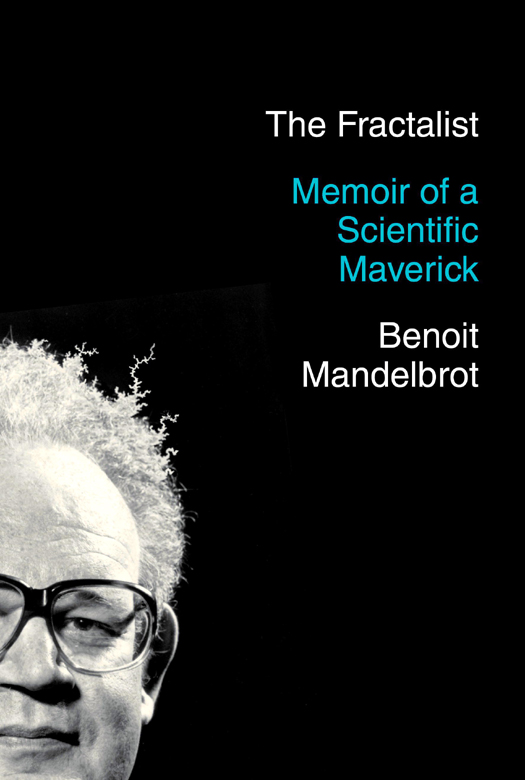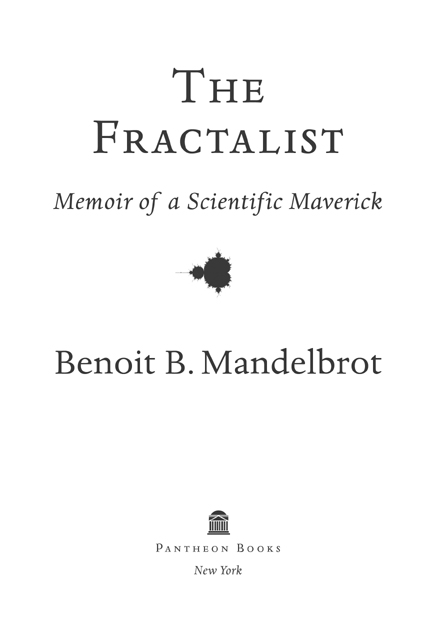Copyright 2012 by The Estate of Benoit Mandelbrot Afterword copyright by Michael Frame
All rights reserved. Published in the United States by Pantheon Books, a division of Random House, Inc., New York, and in Canada by Random House of Canada Limited, Toronto.
Pantheon Books and colophon are registered trademarks of Random House, Inc.
Library of Congress Cataloging-in-Publication Data Mandelbrot, Benoit B.
The fractalist : memoir of a scientific maverick /
Benoit Mandelbrot.
p. cm.
eISBN: 978-0-307-37860-6
1. Mandelbrot, Benoit B.
2. MathematiciansFranceBiography.
3. Fractals. I. Title.
QA29.M34A3 2012
510.92dc22
[B] 2012017896
www.pantheonbooks.com
Cover image Benoit Mandelbrot. Emilio Segre Visual Archives/American Institute of Physics/Photo Researchers, Inc.
Cover design by Peter Mendelsund
v3.1
My long, meandering ride through life
has been lonely and often very rough.
Without loving help, it would have been short,
nasty, and unproductive. But I have been lucky.
Father and Mother taught me the art of survival.
Uncle took me as an unruly but grateful student.
Aliette later joined them, and she, our sons, and
our grandchildren taught me how to smile.
To my steady beacons, these scenes
from a life are dedicated.

This is a memoir of an ardent but bumpy
pursuit of order and beauty in roughness
through mathematics and economics, the
sciences, engineering, and the arts.
It led me to encounter more than my share of
unusually diverse and forceful persons along the way.
Many were warm and welcoming; many were
indifferent, dismissive, hostileeven beastly.
This book cannot possibly mention them all,
but every one taught me something
and to all I owe a great deal.

To the memory of Johannes Kepler,
who brought ancient data and ancient
toys together and founded science.
Contents
Acknowledgments
by Aliette Mandelbrot
M Y HUSBAND DIED shortly before The Fractalist went to the publisher. Benoit spent years writing this memoir. It was a labor of love for him, and my deepest gratitude goes out to the people who kept his words alive.
Without Merry Morse, Benoits able assistant, this memoir would never have been finished. Merry put her astonishing editorial and problem-solving skills to work, preserving his words, style, and spirit. Thank you, Merry, for your hard work, hours beyond counting, coordination with the publishers, and friendship.
Michael Frame, Benoits close friend and colleague at Yale, penned the afterword, consulted with us on the fractal images and technical sections throughout the book, and was always there with ready answers to our seemingly endless list of questions.
Richard Voss, a colleague and friend at IBM Research in Yorktown Heights, reviewed and clarified the section on early computer graphics at IBM, and explained the technology behind the images he generated.
Alan Norton, another colleague of Benoits at IBM Research, reviewed sections of the book related to Julia sets and suggested ideas for using related images.
Benoits collaborator on The (Mis)Behavior of Markets, Richard Hudson, reviewed the sections on finance.
Lisa Margolin searched many hours to find a 1938 map of Byelorussia showing Pooczanka, where Benoit spent one summer of his childhood.
Irene Greif, director of IBM Research in Cambridge, and Charles Lickel, former vice president at IBM Research in Hawthorne, generously gave time to Merry Morse to work on this book.
Maida Eisenberg welcomed Benoit to IBM Research in Cambridge, offering him a congenial and comfortable setting to work on this memoir.
Paul Moody, a research designer at IBM Research in Cambridge, prepared some of the fractal images for this book.
Jane Olingy, administrator at IBM Research in Cambridge, prepared and sent all drafts to the publisher.
Special thanks to Dan Frank at Pantheon, for his invaluable help in shaping the book.
And finally, we appreciate the Alfred P. Sloan Foundation, whose grant supported this book.
Beauty and Roughness
Introduction
N EARLY ALL COMMON PATTERNS IN NATURE are rough. They have aspects that are exquisitely irregular and fragmentednot merely more elaborate than the marvelous ancient geometry of Euclid but of massively greater complexity. For centuries, the very idea of measuring roughness was an idle dream. This is one of the dreams to which I have devoted my entire scientific life.
Let me introduce myself. A scientific warrior of sorts, and an old man now, I have written a great deal but never acquired a predictable audience. So, in this memoir, please allow me to tell you who I think I am and how I came to labor for so many years on the first-ever theory of roughness and was rewarded by watching it transform itself into an aspect of a theory of beauty.

The broad-minded mathematician Henri Poincar (18541912) remarked that some questions one chooses to ask, while others are natural and ask themselves. My life has been filled with such questions: What shape is a mountain, a coastline, a river, or a dividing line between two river watersheds? What shape is a cloud, a flame, or a welding? How dense is the distribution of galaxies in the universe? How can one describeto be able to act uponthe volatility of prices quoted in financial markets? How to compare and measure the vocabularies of different writers? Numbers measure area and length. Could some other number measure the overall roughness of rusted iron, or of broken stone, metal, or glass? Or the complexity of a piece of music or of abstract art? Can geometry deliver what the Greek root of its name seemed to promisetruthful measurement, not only of cultivated fields along the Nile River but also of untamed Earth?
These questions, as well as a host of others, are scattered across a multitude of sciences and have been faced only recently by me. As an adolescent during World War II, I came to worship a major achievement of a mathematician and astronomer of long ago, Johannes Kepler (15711630). Kepler combined the ellipses of ancient Greek geometers with a failure of ancient Greek astronomers, who mistakenly believed that persistent anomalies existed in the motion of planets. Kepler used his knowledge of two different fieldsmathematics and astronomyto calculate that this motion of the planets was not an anomaly. It was, in fact, an elliptical orbit. To discover something like this became my childhood dream.
A most impractical prospect! Not one leading to a career in any organized profession, nor providing a way of shining in lifea prospect that my uncle Szolem, an eminent mathematician, repeatedly called completely childish. Yet somehow fate did allow me to spend my life pursuing that dream. Through extraordinarily good fortune, and a long and achingly complicated professional life, it was eventually fulfilled.


